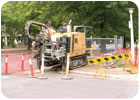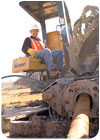
Field-testing of HDD installations was performed at two different locations in order to evaluate the annular space region in both a cohesive and a non-cohesive soil medium. This involved the installation of 200-foot bore lengths of 4-inch, 8-inch and 12-inch high-density polyethylene (HDPE) pipe in two different soil mediums – clay and sand. The depth of each installation was based on pipe diameter. Two feet for the 4-inch diameter pipes; 3 feet for the 8-inch diameter pipes; and 4 feet for the 12-inch diameter pipes.
Field locations were chosen based on the homogeneous consistency of the soil, the topography of the site, and the ability to leave the pipe in the ground for a period of one year to conduct long-term analysis. The two locations used for this research were the University of Alberta farms in Edmonton, Alberta, and the Sil Silica sand pit in Bruderheim, Alberta.
The University of Alberta Farm site was chosen because it provided the cohesive soil medium for this research. The upper 12 feet of the soil at this site consists of uniform homogeneous lacustrine Lake Edmonton clay with a moisture content of approximately 27 percent. The sand site was not completely level; however, it contained a homogeneous medium of consistently fine sand, satisfying the non-cohesiveness requirement, from the surface to beyond the testing depths. The classification of the soils is medium-grained sand to silty sand. Laboratory testing revealed a moisture content of approximately 5 percent.
Installation Process
The installations were conducted over a two-day period, using generally accepted drilling practices to ensure that the data collected reflected not only good drilling practice, but also captured the methods and techniques utilized by the majority of drilling contractors. To this extent, fluted-type reamers were used in both the clay and sand soils. Reamers were sized according to the rule of thumb practice of having reamers 1.5 times the diameter of the product pipe being installed. Subsequently, on the 4-inch pipe installation, a 6-inch reamer was used in a one-pass operation; a 12-inch reamer was used for the 8-inch product pipe with a one-pass installation; and an 18-inch reamer was used for the 12-inch pipe, with a pre-ream using the 12-inch reamer.
Post-installation
Both the clay and sand installations were excavated at sections along the bore path in intervals of one day, one week, two weeks, four weeks and one year after installation to visually assess the integrity of the annular space. The analysis of the annular space region commenced once the installations of the HDPE pipes were completed. These observations were imperative to obtain a better understanding of the annular space region over time.Once the installation of a pipe is achieved, it remains untouched until the next day. Because the 4- and 8-inch pipes were installed in one day, they both were excavated the following day after the installation of the 12-inch pipe. It was decided that the day one excavation of the 12-inch pipe was not necessary, because an indication of the state of the annular space could be observed sufficiently enough through the 4-inch and 8-inch installations. After the initial day one excavation, the pipes were excavated collectively one week, two weeks, four weeks and one year post-installation. The cross-section excavations were conducted along the horizontal section of the bore path near the exit pit side, and continued toward the entry pit on subsequent excavations. All the excavations were done using a backhoe, with hand-digging employed around the perimeter of the pipes. The backhoe excavated to about 1 foot below the depth of installation, and then the hand shovel was used to expose the pipe. Once the area was excavated, a saw was used to cut through the exposed pipe, leaving an open cross section to analyze.
People have hypothesized about the short-term and long-term post-installation state of the annular space, yet very few have actually conducted research in this area. This project involved the evaluation and assessment of:
- The placement of the pipe in relation to the annular space;
- Any existence of voids in the annular space; and
- The state of the annular space in terms of strength, texture and composition.
During the visual examination of the annular space, a geotechnical in-situ test was performed to assess the unconfined shear strength of the annular space and native soil. It should be noted that shear strength tests were only performed at the clay site, as this property never is evaluated in non-cohesive soils such as sand. The in-situ tests were preferred over the laboratory tests, due to the fact that a change in environmental conditions and disturbance of the samples, when extracted, handled and subsequently tested can greatly influence the test results.
In-situ tests and visual assessments validate the hypothesis that all of the pipes that were installed would remain secure, with no evidence of any potential movement. Surface monitoring points placed along the installations revealed that no ground settlement occurred at the surface during installation. Additionally, no ground settlement was observed over time.
ND
Report Abusive Comment